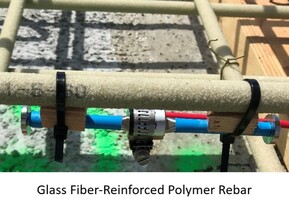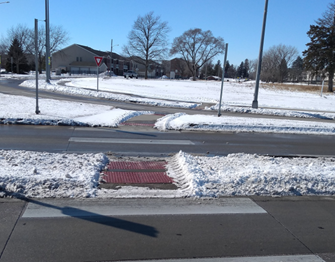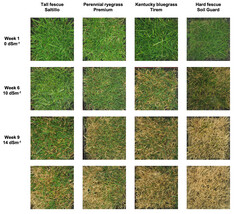|
Transportation Research Update
 Improving and Expanding the Queue Warning System

TRAFFIC & SAFETY — Vehicles coming to a standstill or queueing on a highway can cause hard braking. Similarly, shockwaves that are created when traffic speeds change quickly can cause a cascade of braking. These conditions create risks for rear-end and other crashes. Warning systems use real-time traffic data, vehicle sensors and algorithms that trigger traffic warnings on overhead message boards to alert drivers to conditions ahead.
A queue warning system was previously installed on a crash-prone segment of I-94. Capitalizing on two years of data, researchers evaluated system performance and found crashes decreased 56% and near-crashes decreased 69%. The system, which is integrated with MnDOT’s existing traffic management technology, was then installed in a second location upstream from the original site. Devising a data-driven methodology to evaluate the newly placed system, researchers determined that the system is transferable to other locations, though additional calibration and fine-tuning may be needed.
|
Assessment of GFRP-Reinforced Bridge Decks

BRIDGES & STRUCTURES — Bridge decks in Minnesota are exposed to harsh climate conditions, chlorides from road salts, and freeze-thaw cycles. Typically, steel rebars are embedded in the concrete to reinforce the deck. But the concrete can crack and allow water to seep in, causing rusting of the steel rebars and further concrete cracking. An emerging nonmetallic material, glass fiber-reinforced polymer (GFRP), may be
an effective and longer-lasting alternative to steel rebars.
MnDOT built two side-by-side bridges—one using steel rebars and the other using GFRP rebars as deck reinforcement—on Trunk Highway 169. Building on previous research of Minnesota’s first bridge using GFRP, researchers used this unique opportunity to directly compare the bridges that were subjected to the same environmental and traffic conditions. They found that the structural performance of the GFRP-reinforced bridge deck was comparable (if not better than) the steel-reinforced one. Also, they determined GFRP has the capacity to last longer and be more cost-effective. MnDOT will continue to monitor the performance of the bridge decks and decide if further use of GFRP is warranted.
|
Designing Pedestrian Safety Features for Year-Round Maintenance

TRAFFIC & SAFETY — Pedestrian safety is a priority for MnDOT, including in winter. Safety features in the pedestrian-roadway interface—such as walkways, curb ramps and refuge islands in medians—need to be sufficiently maintained. The design of these features, however, has generally not considered winter maintenance needs. Impacts to snowplowing and other winter maintenance operations from navigating some pedestrian safety treatments have also received little consideration. New research provides options and guidance for MnDOT and other Minnesota agencies seeking to ensure safety and maintainability of pedestrians’ experiences around the roads.
After reviewing existing pedestrian safety designs and interviewing agencies in the northern U.S. and internationally, researchers identified considerations to improve year-round maintainability of pedestrian areas. General recommendations included working with maintenance professionals on designs, ensuring adequate snow storage areas and clarifying responsibilities between agencies and property owners. Specific suggestions for features such as curb ramps, speed bumps, median islands and crosswalks entailed using more durable materials; having adequate drainage; and providing guidelines for shapes, dimensions and sizes. MnDOT and local agencies can begin using the guidance to clarify responsibilities for clearing snow and designing features that keep pedestrians safe and winter maintenance operating smoothly.
|
Evaluating MnDOT’s Turfgrass Seed Variety List and Approval Process

ENVIRONMENTAL — Beyond aesthetic benefits, the turfgrass along Minnesota’s roads helps stabilize the ground supporting the pavement, prevents erosion and filters stormwater to protect water quality in lakes and streams. Innovations in turfgrass seed development result in healthier, more resilient varieties that can withstand changing climate conditions and harsh winters. New research will allow MnDOT to update its approved turfgrass variety list and work with grass seed producers to ensure the state’s roadsides remain healthy and green.
A comprehensive review of field studies and other information aided researchers in evaluating MnDOT’s current approved grass seed list. Data-driven recommendations of varieties that no longer grow well and new ones that have proven performance will allow the agency to revise the list accordingly. Also, seed vendors and others provided survey responses to help fine-tune the agency’s process for approving new grass varieties. This project will result in savings on labor and materials costs and identify turfgrass varieties that need less maintenance and create more visually appealing, sustainable roadsides.
|
|
|
|
MnDOT invites and encourages participation by all people in their programs, services and activities.
If you need an ASL, a foreign language interpreter, or documents in an alternative format (such as braille, large print or in a different language) at no cost, please email your request to Janet Miller at ADArequest.dot@state.mn.us or call 651-366-4720. Relay service: 711.
If you need any other reasonable accommodation to participate (such as seating modification or auxiliary aids), please email your request to Accessibility.DOT@state.mn.us or call 1-833-400-8432. Relay service: 711.
|
|
|
|